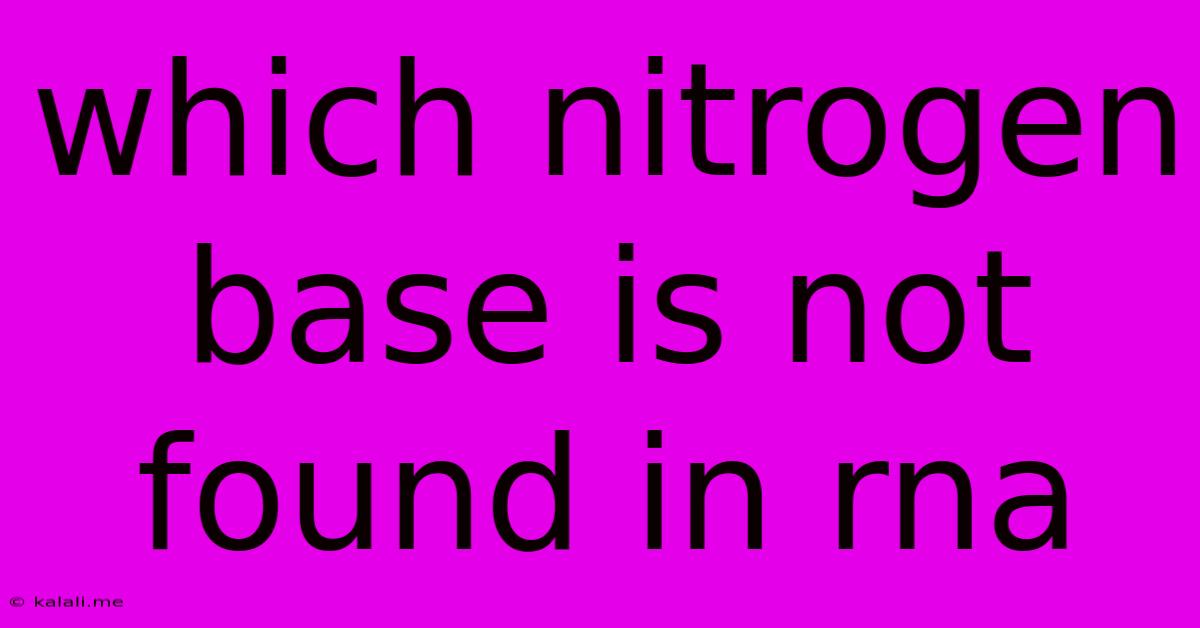Which Nitrogen Base Is Not Found In Rna
Kalali
Jun 16, 2025 · 3 min read

Table of Contents
Which Nitrogen Base is Not Found in RNA? Unlocking the Secrets of RNA and DNA
This article delves into the fundamental differences between RNA (ribonucleic acid) and DNA (deoxyribonucleic acid), focusing specifically on the nitrogenous bases that make up their structures. Understanding these differences is crucial to comprehending the roles of RNA and DNA in cellular processes. We'll explore why a particular nitrogenous base, found in DNA, is absent in RNA.
The Building Blocks of Nucleic Acids:
Both RNA and DNA are composed of nucleotides, which are the fundamental units of these nucleic acids. Each nucleotide consists of three components: a five-carbon sugar (ribose in RNA and deoxyribose in DNA), a phosphate group, and a nitrogenous base. It's the nitrogenous base that distinguishes the different nucleotides and ultimately defines the genetic code.
There are five main nitrogenous bases involved in the construction of DNA and RNA: adenine (A), guanine (G), cytosine (C), thymine (T), and uracil (U).
The Key Difference: Thymine vs. Uracil
The crucial difference between RNA and DNA lies in one specific nitrogenous base: thymine (T) is found only in DNA, while uracil (U) is found only in RNA. Both thymine and uracil are pyrimidines, a type of nitrogenous base characterized by a single-ring structure. They differ by a single methyl group; thymine has a methyl group (CH3) attached to its carbon ring, while uracil does not.
Why the Substitution? A Closer Look at the Chemical Properties
The substitution of uracil for thymine in RNA is not arbitrary. It's believed that this substitution offers certain advantages in terms of RNA's functionality and stability. Thymine's methyl group offers increased resistance to chemical modifications, which could be detrimental to RNA molecules, given their involvement in diverse cellular processes and their shorter lifespan compared to DNA. Uracil's higher susceptibility to spontaneous deamination (loss of an amino group), while seemingly a disadvantage, is actually mitigated by cellular repair mechanisms which easily detect and correct uracil misincorporations in RNA, preventing genetic errors.
The Roles of RNA and DNA:
Understanding the unique composition of RNA and DNA is key to grasping their distinct roles in the cell:
-
DNA: DNA serves as the primary repository of genetic information. Its double-stranded helix structure provides stability and protection for the genetic code.
-
RNA: RNA plays multiple critical roles, including protein synthesis (messenger RNA or mRNA), transferring amino acids to the ribosome (transfer RNA or tRNA), and forming the structural core of ribosomes (ribosomal RNA or rRNA). Its single-stranded nature allows for greater flexibility and interaction with other molecules.
In Summary:
To reiterate, the nitrogenous base thymine (T) is not found in RNA. Instead, RNA utilizes uracil (U). This seemingly small difference in chemical structure has significant implications for the stability and functionality of these crucial biomolecules, underpinning the distinct roles of DNA and RNA in the central dogma of molecular biology. Understanding this distinction is fundamental to a comprehensive understanding of genetics and molecular biology.
Latest Posts
Latest Posts
-
How To Create Clickable Image In Html
Jun 16, 2025
-
What Are The Factors Of 121
Jun 16, 2025
-
What Is A Theme Of The Passage
Jun 16, 2025
-
A Company That Provides Access To The Internet
Jun 16, 2025
-
Which Word Is Closest In Meaning To The Underlined Word
Jun 16, 2025
Related Post
Thank you for visiting our website which covers about Which Nitrogen Base Is Not Found In Rna . We hope the information provided has been useful to you. Feel free to contact us if you have any questions or need further assistance. See you next time and don't miss to bookmark.